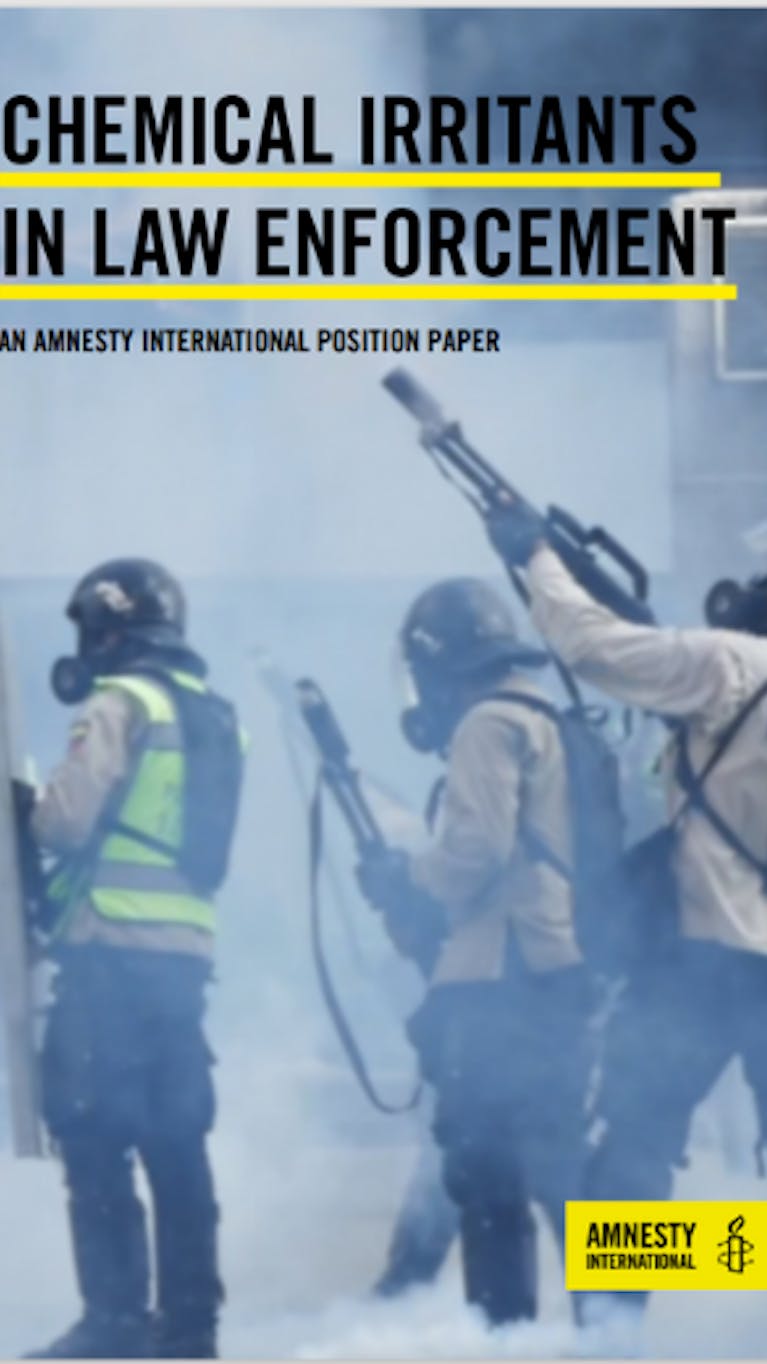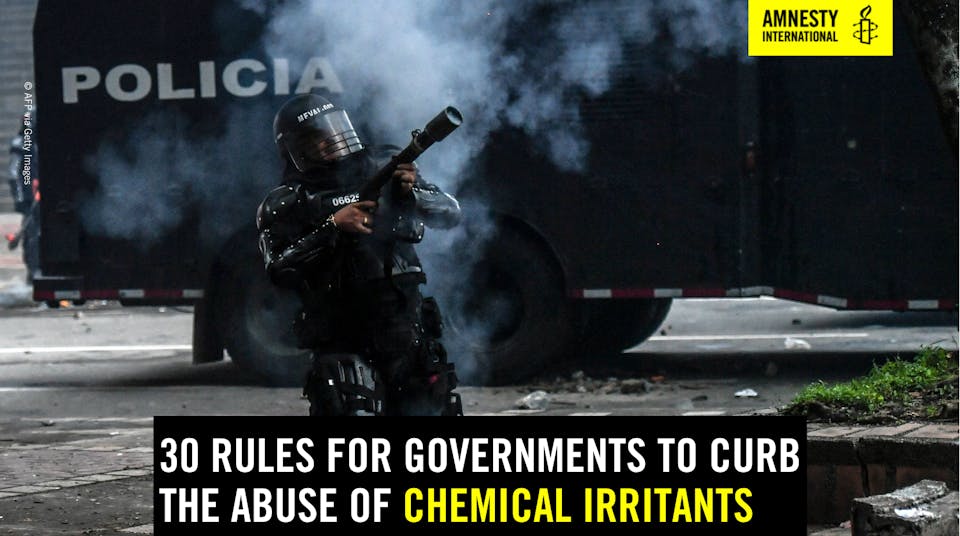
Amnesty International releases 30 rules to curb the use of chemical irritants by police
Across the world, from the streets of Thailand to Philadelphia (USA), from Greece to Chile, the police continue to use tear gas and pepper spray unlawfully and unnecessarily, resulting in serious injury and even death.
In countless cases, police are too quick to disperse peaceful protesters through the use of force instead of seeking peaceful conflict resolution resorting to tear gas, pepper spray and water cannons in an arbitrary, abusive or excessive way, often with little or no accountability.
Amnesty International is responding to this serious deficiency in law enforcement by publishing a comprehensive new paper to ensure that police only use tear gas and pepper spray lawfully. The organization urges governments to bring national law and implementation in line with 30 rules for the use of chemical irritants in law enforcement.
All too often, in many countries around the world, people are seriously injured and sometimes even killed when police use tear gas in violation of international standards or existing national laws,
said the report’s author, Dr Anja Bienert of Amnesty International Netherlands’ Police and Human Rights Programme.
Nobody is disputing that police have a challenging, and often even dangerous, duty to perform. But authorities frequently fail to create a framework to ensure that police use chemical irritants in line with international human rights law and standards.
The report Cali: In the epicentre of repression, Amnesty International publishes today on the policing of protests in Cali (Colombia), illustrates the serious human rights problems involved when law enforcement agencies resort to the use of chemical irritants in the context of protests. Tear gas was used against peaceful protestors; grenades were fired at close range directly against protestors, including aiming at the head; they were used in situations when people were unable to disperse; they were fired at night time, and from above as well as in excessive quantities through the use of the multiple launcher system Venom.
The power to use force is indispensable for police to carry out their duties, but that does not mean it is inevitable. The underlying principle of the international standards for police is not to use force unless it is really necessary.

Amnesty International calls on states to stop the abuse of chemical irritants.
In Colombia, security forces used tear gas grenade launchers to fire at close range against demonstrators, including aiming at the head. They also used tear gas when people were unable to disperse, at night time, and from above, and in excessive quantities through the use of the multiple launcher system Venom. © AFP via Getty Images

In Greece, the police resorted unnecessarily and excessively to the use of tear gas against peaceful protesters. © Panayotis Tzamaros/NurPhoto

n Portland (Oregan,USA) police sprayed pepper-spray into the face of an arrested man. Using pepper spray on a person who is already restrained or otherwise under control would amount to torture or other ill-treatment. © Anadolu Agency via Getty Images

Tear gas canisters can hit a person directly, cause penetration wounds, concussion, other head injuries and, in severe instances, death. In Gaza, a 12-year-old boy was shot in his eye with tear gas canister fired by Israeli soldiers during "Great March of Return" protests. © Getty Images

Law enforcement must never shoot teargas directly at people. In Myanmar, armed forces personnel shot teargas and ammunition directly at people in the street. © 2021 SOPA Images

Chemical irritants must not be used where people can not disperse and their use should not lead or aim to corner people.
Across the USA, many law enforcement agencies targeted peaceful Black Lives Matter protesters with tear gas; e.g. in Philadelphia, protesters were trapped on a steep highway embankment after being targeted with tear gas. © Mark Makela Getty

The police in Hong Kong deployed teargas in the Metro station, where people were unable to disperse. © Alamy

During the protests in Thailand, the police excessively used chemical irritants on crowds, including tear gas and water cannon discharge. Victims report suffering injuries such as severe burns and nasal bleeding.
The combined use of chemical irritants with devices that risk causing excessive harm and would serve contradictory operational purposes should be prohibited. © AFP via Getty Images

When tear gas comes from above, people have no clear direction to disperse. This increases the risk of chaos, disorientation, panic and even a stampede. In addition, wind makes the spread and diffusion of tear gas unpredictable, likely to affect uninvolved people. The Israeli army deployed drones throwing teargas grenades on Palestinian protesters in the Gaza strip. © AFP via Getty Images

Misuse of tear gas and pepper spray: a global problem
Over the years, Amnesty International documented police abusing tear gas in multiple ways, including:
- Firing into confined spaces. For example, in Zambia, a final year student died of suffocation after police threw a tear gas canister in the dorm where she was sleeping. Likewise, in June 2021, Tunisia security forces recklessly fired tear gas in residential areas. They fired tear gas inside homes, which nearly suffocated a two-week-old baby. In May 2021, Israeli security forces fired tear gas inside the al-Aqsa mosque and from rooftops. Witnesses said they broke windows and threw in tear gas, leaving many people inside struggling to breathe. In March 2021, Iranian security forces used live ammunition and tear gas to suppress protests in several prisons.
- Firing directly at individuals. In Lebanon, for example, security forces used tear gas to disperse a largely peaceful protest. Security forces fired tear gas canisters directly at protesters and from a moving vehicle, making controlled deployment impossible. This has led to serious head and upper body injuries among protesters. In Myanmar, armed forces personnel also shot teargas and ammunition directly at people in the street.
- Using excessive quantities. During the protests in Thailand, the police excessively used chemical irritants on crowds, including tear gas and water cannon discharge. Victims report suffering injuries such as severe burns and nasal bleeding.
- Firing at peaceful protests. In dozens of cities across the USA, many law enforcement agencies targeted peaceful Black Lives Matter protesters with tear gas and other crowd control agents. In Greece, the police also resorted unnecessarily and excessively to the use of water cannon and tear gas against peaceful protesters.
In May 2021, Amnesty International’s online multimedia project, Tear Gas: An Investigation, won a prestigious Webby Award for the best activism website worldwide. The website includes an interactive map highlighting videos of more than 100 incidents of tear gas misuse from 31 countries and territories.
30 rules
Amnesty International’s position paper clarifies that police can only use tear gas in the case of widespread violence when it is impossible to deal with violent individuals alone. They should never use tear gas to disperse peaceful protesters. Grenades should never be fired directly at persons. Tear gas should be used to disperse violent protestors and therefore should never be used in confined spaces or other areas where people are unable to disperse. Handheld pepper spray may only be used to overcome violent resistance but not against persons who are only passively resisting. Its use against people already under control would amount to torture or other ill-treatment.
The position paper is a practical tool for anyone assessing the use of teargas and pepper spray by police and advocating for greater respect for human rights.
With this paper, we aim to provide legal and practical measures which states must take to ensure police use of force is not excessive, abusive, arbitrary or otherwise unlawful. For this to happen, full accountability must be ensured for any use of force by police,
said Dr Bienert.
The use of tear gas during the COVID-19 pandemic bears considerable additional risks since it could worsen the symptoms of those carrying the COVID-19 virus and increase the risk of infection for others.
International regulations needed
Despite its widespread misuse, there are no agreed international regulations on the trade in tear gas and other chemical irritants.
Amnesty International urges states not to authorize the export of chemical irritants, such as tear gas or pepper spray, related launchers and technical assistance, when there are reasonable grounds for believing that the equipment will be used for serious human rights violations.
The organization is further calling for a prohibition of the combined use of chemical irritants with other devices and multiple launch systems and launchers.
For more information or to arrange an interview, please contact the Police and Human Rights Program : phrp@amnesty.nl
Read more:
Chemical irritants in law enforcement (Research, 30 July 2021)
30 Rules for the use of chemical irritants in law enforcement (Research, 30 July 2021)